 W
WRecently extinct mammals are defined by the International Union for Conservation of Nature (IUCN) as any mammals that have become extinct since the year 1500 CE. Since then, roughly 80 mammal species have become extinct.
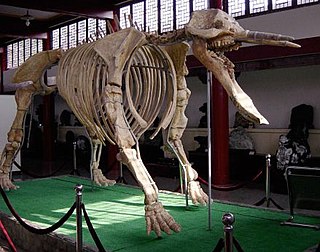 W
WAmebelodontidae is an extinct family of large herbivorous mammals that were closely related to elephants. They were formerly assigned to Gomphotheriidae, but recent authors consider them a distinct family.
 W
WThe Anancidae are an extinct family of large herbivorous mammals that were closely related to modern elephants. They were assigned to the Gomphotheriidae in the past, but recent authors consider them a distinct family. Under the Gomphotheriidae sensu lato, they were known as the tetralophodont gompotheres based on their molar morphology.
 W
WThe aurochs, also known as urus or ure, is an extinct species of large wild cattle that inhabited Asia, Europe, and North Africa. It is the ancestor of domestic cattle. The species survived in Europe until 1627, when the last recorded aurochs died in the Jaktorów Forest, Poland.
 W
WBalaenula is an extinct genus of cetacean.
 W
WThe Balearic shrew is an extinct species of shrew from Majorca and Menorca, in the Balearic Islands of Spain, belonging to the endemic genus Nesiotites. It was one of three native land mammals to the Balearic Islands, alongside Myotragus and Hypnomys. Nesotites has been present in the Balearic Islands for over 5 million years since the Late Miocene-Early Pliocene, and is the final and largest chronospecies of the lineage. It was relatively large for a shrew, being estimated to weigh between 20 to 30 grams. Among living shrews it is most closely related to the Himalayan shrew, from which it diverged around 6.44 million years ago and has a probable close relationship with the extinct genus Asoriculus of mainland Europe and Corsica-Sardinia.
 W
WCanariomys is an extinct genus of rodents that once existed on the islands of Tenerife and Gran Canaria, part of the Canary Islands, Spain. These giant rats could reach a weight of about 1 kg (2.2 lb). They were herbivores; their diet was based on plant materials, probably soft vegetables such as roots, ferns, and berries, but not grass. C.tamarani were considered herbivores, eating everything plant like except grass with good digging skills. While C.bravoi were considered as a rat character, because of its large size, with an omnivorous diet with good climbing skills.
 W
WThe Caucasian moose, also known as the Caucasian elk was a subspecies of moose found in the Caucasus Mountains of Eastern Europe and Asia Minor. It is widely believed to be extinct.
 W
WThe Caucasian wisent or dombay (домбай) was a subspecies of European bison that inhabited the Caucasus Mountains of Eastern Europe.
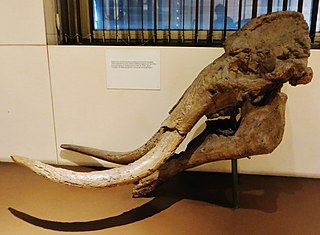 W
WChoerolophodontidae is an extinct family of large herbivorous mammals that were closely related to elephants. Two genera are known, Afrochoerodon and Choerolophodon.
 W
WThe Cuesta sea cow is an extinct herbivorous marine mammal, and the direct ancestor of the Steller's sea cow. They reached up to 9 metres (30 ft) in length, making them among the biggest sirenians to have ever lived. They were first described in 1978 by Daryl Domning when fossils in California were unearthed. Its appearance and behavior are largely based on that of the well-documented Steller's sea cow, which, unlike the Cuesta sea cow, lived into modern times and was well-described.
 W
WThe North African elephant is an extinct subspecies of the African bush elephant, or possibly a separate elephant species, that existed in North Africa, north of the Sahara, until it died out in Roman times. These were the famous war elephants used by Carthage in the Punic Wars, their conflict with the Roman Republic. Although the subspecies has been formally described, it has not been widely recognized by taxonomists. Other names for this animal include the North African forest elephant, Carthaginian elephant, and Atlas elephant. Originally, its natural range probably extended across North Africa and down to the present Sudanese and Eritrean coasts.
 W
WEquus scotti is an extinct species of Equus, the genus that includes the horse.
 W
WEquus namadicus is a prehistoric equid, known from equid remains dating to the Pleistocene excavated in deposits of the Narmada river, in India. It is contemporary and possibly even identical to, Equus sivalensis.
 W
WThe European wild ass or hydruntine is an extinct equine from the Middle Pleistocene to Late Holocene of Western Eurasia. It appeared first in the fossil record around 350-300,000 years before present. In the late Pleistocene it was widespread throughout much of western Eurasia from the Middle East to Europe, especially along the Mediterranean, with fossil reports from Sicily, Turkey, Spain, France and Portugal. In the east the range apparently stretched at least to the Volga and to Iran. In the north it reached almost to the North Sea in Germany and the British Isles. Its range fragmented after the Last Glacial Maxiumum, surviving into the Holocene, its range gradually contracted further, persisting in small regions of southern Europe into the Bronze age, and in Iran and the Caucasus into the Iron Age, around 500 BC. It has been suggested that the Iberian Zebro, extinct in the wild from the 16th century, could correspond to the Equus hydruntinus, although the word "zebro" or "cebro" comes from Latin equiferus meaning 'wild horse'. Later research judged that it was unlikely that hydruntines persisted in the Iberian Peninsula beyond the Chalcolithic.
 W
WThe small Mauritian flying fox or dark flying fox is an extinct species of megabat. It lived on the islands of Réunion and Mauritius in the Mascarene Islands of the Indian Ocean. It was abundant, with up to 400 sometimes crowding together at a single roost in a cave or in an ancient, hollow tree, while most other fruit bats prefer to roost in the branches of large trees. Local people believed there was only one male per roost, which may indicate the sexes roosted separately and the large roosts were maternity colonies. This flying fox was nocturnal and had delicate teeth, so it probably fed on nectar and possibly soft fruit.
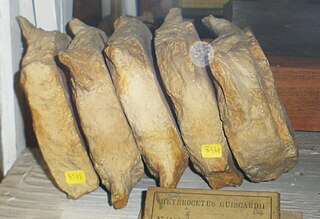 W
WHeterocetus is a dubious genus of extinct cetacean.
 W
WHipposideros besaoka is an extinct bat from Madagascar in the genus Hipposideros. It is known from numerous jaws and teeth, which were collected in a cave at Anjohibe in 1996 and described as a new species in 2007. The site where H. besaoka was found is at most 10,000 years old; other parts of the cave have yielded H. commersoni, a living species of Hipposideros from Madagascar, and some material that is distinct from both species. H. besaoka was larger than H. commersoni, making it the largest insectivorous bat of Madagascar, and had broader molars and a more robust lower jaw. As usual in Hipposideros, the second upper premolar is small and displaced from the toothrow, and the second lower premolar is large.
 W
WHydrodamalinae is a recently extinct subfamily of the sirenian family Dugongidae. The Steller's sea cow was hunted to extinction by 1768, while the genus Dusisiren is known from fossils dating from the middle Miocene to early Pliocene.
 W
WMegabelodon is an extinct gomphotherid genus of proboscid which inhabited North America in from the Miocene to the Pliocene. Specimens were found in Nevada and New Mexico. The genus has been disputed, with some paleontologists considering Megabelodon as a synonym of Gomphotherium.
 W
WMegalohyrax is an extinct hyrax-grouped genus of herbivorous mammal from the Lower Oligocene, about 33–30 million years ago. Its fossils have been found in Africa and in Asia Minor.
 W
WMicrogale macpheei is an extinct shrew tenrec from southeastern Madagascar. It is known only from two partial skulls found in Andrahomana cave, which radiocarbon dating of associated rodent remains suggests are about 3000 years old. It is the only known recently extinct tenrec. First described in 2007, it is most similar to the smaller Microgale brevicaudata of northern and western Madagascar. M. macpheei has a broad rostrum and, like M. brevicaudata, lacks a diastema (gap) between the premolars. A number of details of tooth morphology are characteristic of M. macpheei.
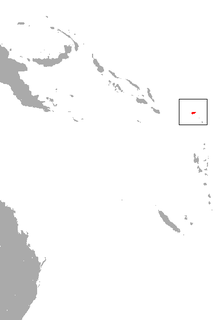 W
WThe Nendo or Santa Cruz tube-nosed fruit bat is a megabat from the Santa Cruz Group of the Solomon Islands, near the eastern limit of the distribution of tube-nosed fruit bats. It has tube-like nostrils and a wingspan of about 40 cm.
 W
WNespohontes hemicingulus is an extinct eulipotyphlan of the genus Nesophontes that was once endemic to the Cayman Islands ; the shrew lived in the island montane forest/brush endemic to the Cayman Islands and was an insectivore. It is known from subfossil remains, that bear bite marks attributed to crocodiles, collected from caves, sinkholes and peat deposits on the Islands between the 1930s and the 1990s. It was named in 2019.
 W
WPachyhyrax was a genus of herbivorous hyrax-grouped mammal belonging to the clade Paenungulata.
 W
WPlesielephantiformes is an extinct suborder of large herbivorous mammals that were closely related to elephants.
 W
WThe Portuguese ibex is an extinct subspecies of Spanish ibex that inhabited the north mountainous zones of Portugal, Galicia, Asturias and western Cantabria. In size and colouration it was much like the Spanish animals, though inclining towards brown rather than black markings. Its horns were strikingly different from any of the other Iberian subspecies. They were only half the length of the Pyrenean ibex, but were almost twice as wide, and, consequently, much closer together at their base.
 W
WProgomphotherium is an extinct genus of large herbivorous mammals that were closely related to elephants.
 W
WThe Queen Charlotte Islands caribou or Dawson's caribou is an extinct subspecies of the reindeer that once lived on Graham Island, the largest of the Haida Gwaii islands in British Columbia, Canada. Possible causes of extinction include habitat destruction, introduced disease and overhunting. It was grey in appearance. The last three caribou were killed in 1908 and can be seen at the Royal British Columbia Museum, where their pelts and bones are preserved and displayed. Recent analysis of mtDNA suggests that the Queen Charlotte Islands caribou was not genetically distinct from the subspecies from the Canadian mainland.
 W
WRonzotherium is an extinct genus of perissodactyl mammal from the family Rhinocerotidae. The name derives from 'Ronzon', the Belgian locality at which it was first discovered, and the greek suffix 'therium' meaning 'beast'. At present 5 species have been identified from several localities in Europe and Asia, spanning the Late Eocene to Upper Oligocene.
 W
WThe Sardinian pika is an extinct pika that was native to the islands of Sardinia, Corsica and neighbouring Mediterranean islands until its extinction in the Roman times or perhaps as late as the late 1700s or early 1800s.
 W
WThe Schomburgk's deer was a member of the family Cervidae. Native to central Thailand, Schomburgk's deer was described by Edward Blyth in 1863 and named after Sir Robert H. Schomburgk, who was the British consul in Bangkok from 1857 to 1864. It is thought to have gone extinct by 1938, but there is speculation that the deer might still exist.
 W
WStegotetrabelodontinae is an extinct subfamily of large herbivorous mammals that were closely related to elephants. Remains have been found in Southern Italy.
 W
WSteller's sea cow is an extinct sirenian described by Georg Wilhelm Steller in 1741. At that time, it was found only around the Commander Islands in the Bering Sea between Alaska and Russia; its range was more extensive during the Pleistocene epoch, and it is possible that the animal and humans previously interacted. Some 18th-century adults would have reached weights of 8–10 t and lengths up to 9 m (30 ft).
 W
WThe Syrian elephant or Western Asiatic elephant is a proposed name for the westernmost population of the Asian elephant, which became extinct in ancient times. Skeletal remains of E. m. asurus have been recorded from the Middle East: Iran, Iraq, Turkey and Syria, from periods dating between at least 1800 BC and likely 700 BC. Due to the lack of any Late Pleistocene or early to mid Holocene record for Asian elephants in the region, it has been suggested to have been anthropogenically introduced during the Bronze Age, though this is disputed.
 W
WThe Syrian wild ass, less commonly known as a hemippe, an achdari, or a Mesopotamian or Syrian onager, is an extinct subspecies of onager native to the Arabian peninsula and surrounding areas. It ranged across present-day Iraq, Palestine, Israel, Iran, Jordan, Saudi Arabia, Syria, and Turkey.
 W
WTriaenops goodmani is an extinct bat from Madagascar in the genus Triaenops. It is known from three lower jaws collected in a cave at Anjohibe in 1996, and described as a new species in 2007. The material is at most 10,000 years old. A bat humerus from the same site could not be identified as either T. goodmani or the living T. menamena. T. goodmani is identifiable as a member of Triaenops or the related genus Paratriaenops by a number of features of the teeth, such as the single-cusped, canine-like fourth premolar and the presence of a gap between the entoconid and hypoconulid cusps on the first two molars. T. goodmani is larger than the living species of Triaenops and Paratriaenops on Madagascar, and on the first molar the protoconid cusp is only slightly higher than the hypoconid, not much higher as in the other species.
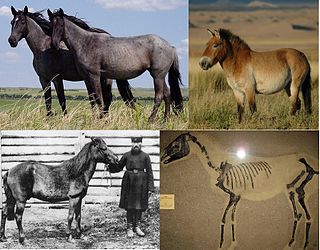 W
WThe wild horse is a species of the genus Equus, which includes as subspecies the modern domesticated horse as well as the undomesticated tarpan, and the endangered Przewalski's horse.
 W
WXenotrichini is a tribe of extinct primates, which lived on the Greater Antilles as recently as the 16th century.